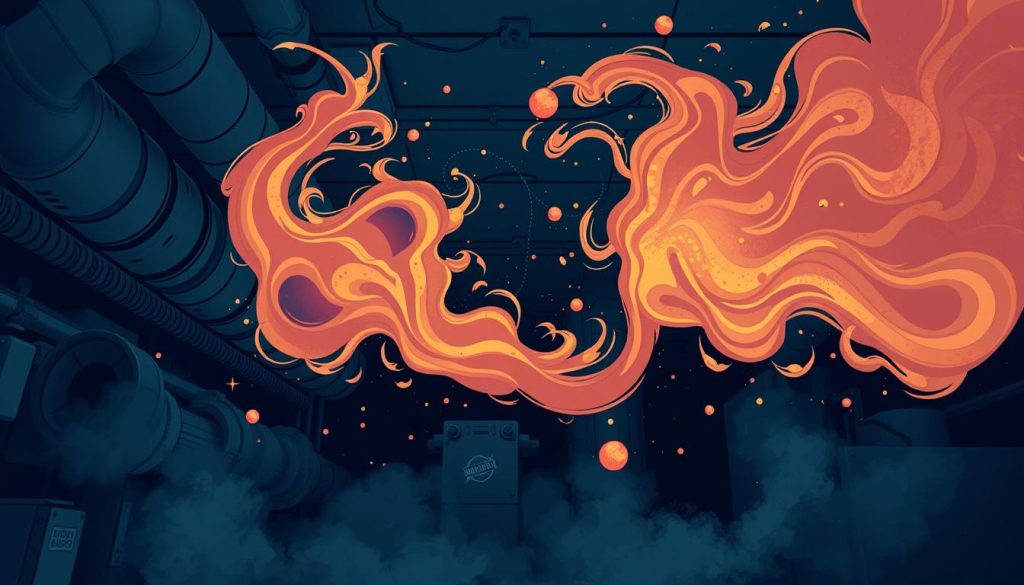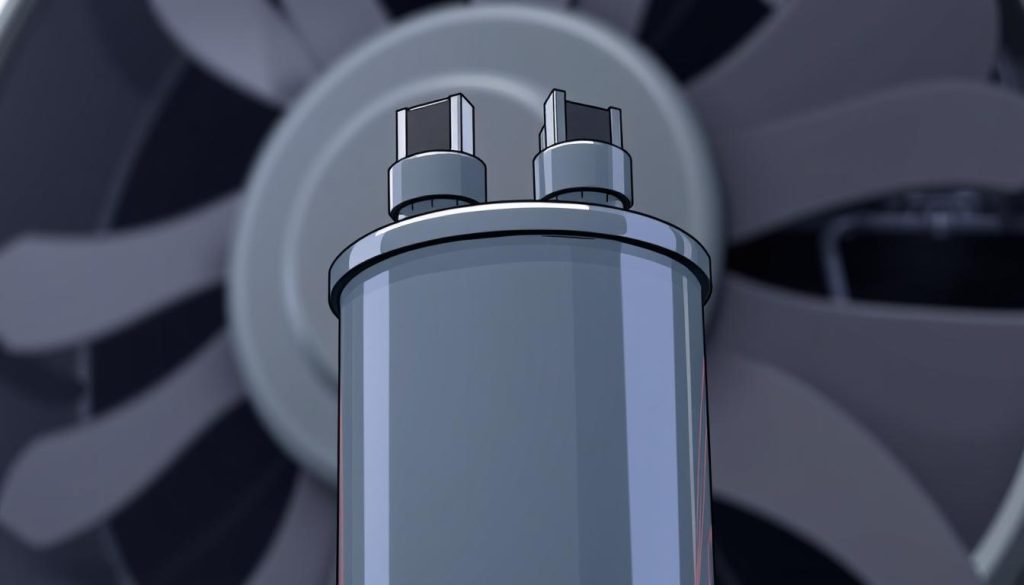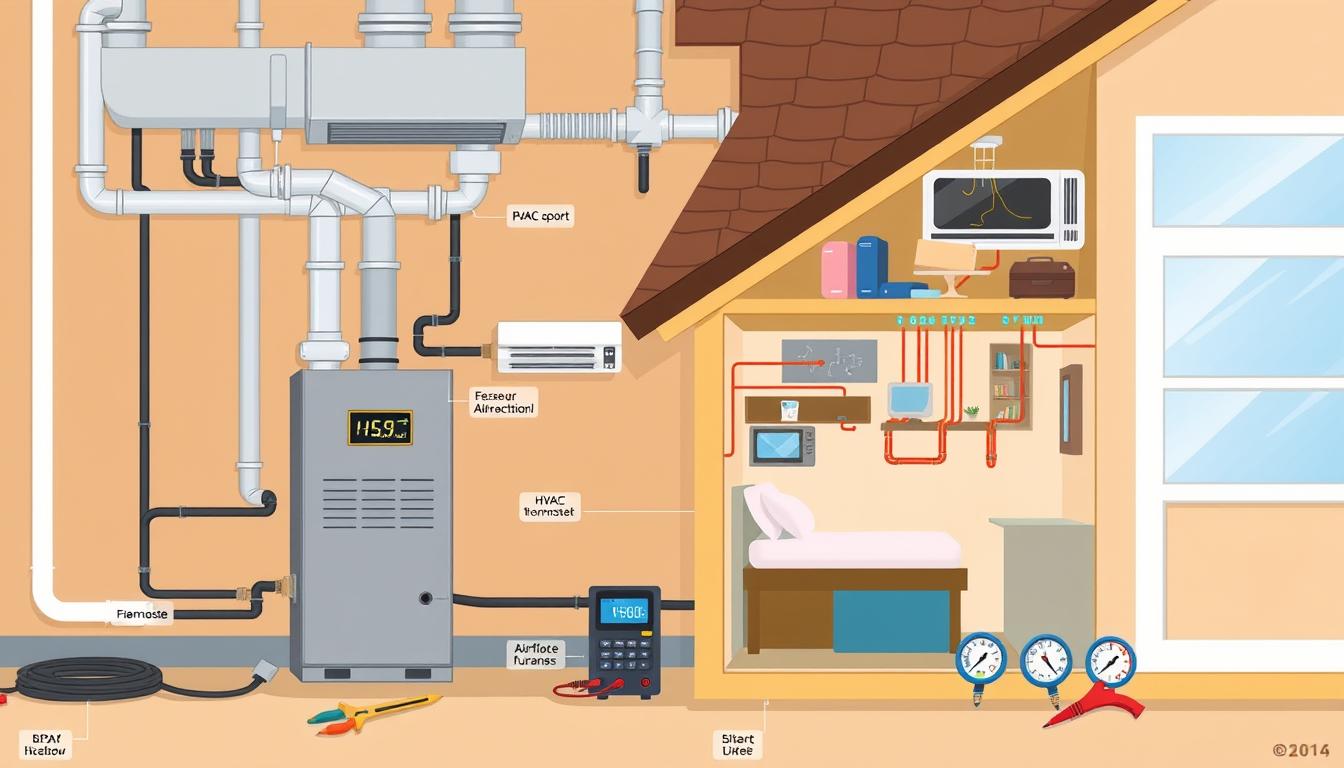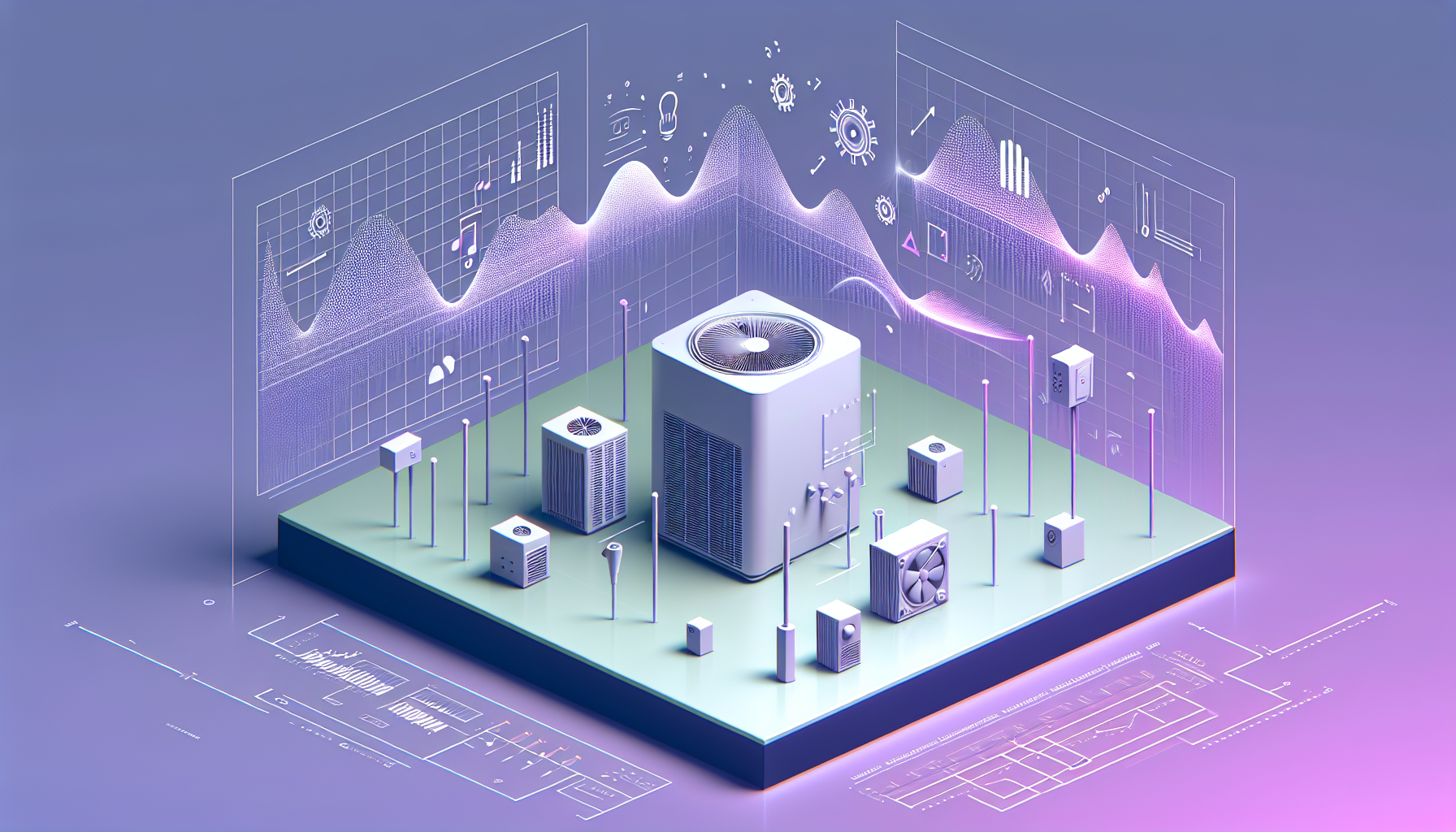As a homeowner, knowing how to find and fix problems with your HVAC system is key. Your HVAC system keeps your home comfortable. Over time, issues can pop up. By learning to spot common problems and following a step-by-step guide, you can often fix these issues yourself. This guide will help you understand your HVAC system and solve common problems.
Key Takeaways
- Understand the components and workings of your HVAC system to identify issues more effectively.
- Learn to recognize common HVAC problems, such as AC not turning on, short cycling, and unusual noises.
- Troubleshoot HVAC issues step-by-step to determine the root cause before calling a professional.
- Maintain your HVAC system regularly to prevent future problems and ensure optimal performance.
- Act promptly to address HVAC issues to avoid further damage and maintain your home’s comfort.
Understanding Your HVAC System
Your HVAC system is key to your home’s comfort. It keeps you warm in winter and cool in summer. Knowing how it works helps you spot and fix problems.
What Is an HVAC System and What Does It Do?
An HVAC system controls your home’s temperature, humidity, and air quality. It includes air purifiers, heat pumps, and smart thermostats. The heating part warms the air, while the cooling part cools it down.
How Does an HVAC System Work?
The HVAC system moves heat around. In winter, it warms the air and sends it through ducts. In summer, it cools the air and sends it back in. It also ensures good air flow and quality.
Knowing your HVAC system’s parts and how it works is crucial. It helps you keep it running well and fix any issues. This way, your home stays comfortable all year.
How to diagnose an HVAC issue?
Diagnosing an HVAC issue is key to keeping your system running well. By following a step-by-step approach, you can find the problem’s source. This helps you decide if you can fix it yourself or if you need a pro.
To start diagnosing an HVAC issue, check the basics:
- First, look at the power supply. Make sure the system has electricity by checking the circuit breakers or fuses.
- Next, check the thermostat. It should be set right and getting power.
- Then, look for any damage or problems with the HVAC parts, like air filters, ductwork, and coils.
If the power and thermostat seem fine but issues persist, it’s time for more detailed HVAC troubleshooting and HVAC diagnostics.
| Common HVAC System Problems | Possible Causes |
|---|---|
| AC Won’t Turn On | Tripped circuit breaker, faulty thermostat, or compressor issues |
| AC Constantly Turning On and Off | Refrigerant leaks, clogged air filters, or issues with the compressor |
| Odd Noises | Loose components, faulty motors, or problems with the blower |
By doing a detailed HVAC inspection and fixing any HVAC system problems, you can make sure your HVAC system works great. This ensures your home or business stays comfortable.
Common HVAC Problems and Solutions
Dealing with a broken HVAC system is frustrating. Issues like AC not turning on or AC short cycling can make your home uncomfortable. Let’s look at common problems and how to fix them.
AC Won’t Turn On
When your air conditioner won’t start, it’s a common problem. It could be the thermostat, a tripped breaker, or the condenser unit. First, check your thermostat settings. Make sure it’s set to cool.
If that doesn’t work, check your electrical panel for tripped breakers. Reset them if needed. If it still doesn’t work, look at the condenser unit for damage or blockages.
AC Constantly Turning On and Off
AC short cycling is when it turns on and off too fast. It might be a dirty air filter, clogged coils, or an oversized unit. Start by cleaning or replacing the air filter and clearing the condenser unit.
If it keeps happening, a pro should check it. They can look for issues like a bad thermostat or the wrong-sized unit.
Odd Noises
Strange HVAC noises mean something’s wrong. A loud sound might be the blower fan, while a soft click could be a loose part. Check for loose parts and tighten them.
If the noises don’t stop, a pro should look at it. They can find and fix the real problem.
Fixing these HVAC troubleshooting issues quickly keeps your system running well. This keeps your home comfortable all year.
Poor Airflow Issues
If you’re having trouble with HVAC airflow in your home, it might be due to several reasons. Ductwork problems are a common culprit. Knowing what causes poor airflow can help you fix it.
What Causes HVAC Airflow Problems?
Blocked or disconnected ductwork is a major cause of HVAC airflow issues. Debris, dust, and small animals can block air flow. Also, ductwork issues like leaks or wrong sizes can cause problems.
Insufficient return air vents are another common issue. Your HVAC system needs a balanced air flow. Without enough return vents, or if they’re blocked, airflow suffers.
| Common Causes of HVAC Airflow Problems | Solutions |
|---|---|
| Blocked or Disconnected Ductwork | Inspect and clean ductwork, repair any leaks or disconnections |
| Insufficient Return Air Vents | Install additional return air vents to balance the system |
| Dirty Furnace Filters | Replace furnace filters regularly to maintain airflow |
| Oversized Ductwork | Consult with an HVAC professional to properly size the ductwork |
If you think your HVAC system has poor air circulation or HVAC airflow problems, fix it fast. This ensures your home stays comfortable and energy-efficient. An HVAC expert can help find and fix the issue.
Dirty Evaporator Coils
The evaporator coils are key to your HVAC system’s efficiency. They absorb heat from the air, keeping your home cool and comfortable. But, if they get dirty, it can cause big problems.
Dirty coils can lead to poor cooling, longer cycles, ice buildup, and higher bills. Cleaning them regularly is vital to keep your system running well.
How Do Dirty Evaporator Coils Affect Your HVAC System?
Dirt on the coils blocks airflow and hampers heat absorption. This makes your system work harder, using more energy and running longer. It can even freeze the coils, causing more issues and possibly breaking the system.
Signs of Dirty Evaporator Coils
- Reduced cooling capacity: If your home isn’t cooling as well, dirty coils might be the cause.
- Longer run times: If your system runs longer to cool your home, it’s likely the coils are dirty.
- Icy coils: Seeing ice on the coils means they need a clean.
- Increased energy bills: Dirty coils make your system work harder, raising your energy costs.
Cleaning and Maintaining Evaporator Coils
If you can’t clean the coils yourself, call a professional HVAC technician. They have the right tools and know-how to clean them properly. This ensures your system cools efficiently and keeps your home comfortable.
| Condition | Impact on HVAC System | Recommended Action |
|---|---|---|
| Clean Evaporator Coils | Optimal heat absorption, efficient cooling | Maintain regular cleaning schedule |
| Dirty Evaporator Coils | Reduced cooling capacity, longer run times, higher energy bills | Contact HVAC professional for thorough cleaning |
Unpleasant Odors from HVAC System
If you notice bad smells coming from your HVAC system, you need to act fast. These HVAC odors can smell like dirty socks or burning. They can really hurt your HVAC indoor air quality. Knowing why they happen and fixing them is key to a healthy home.
What Causes HVAC Odors?
HVAC odors come from many issues, like:
- A dirty drain pan
- A frozen evaporator coil
- Too much moisture in the air ducts
- A blocked condensate line
- An air conditioning unit that’s too small
These problems can cause mold and other bad stuff. This stuff can make your home smell bad.
How to Identify the Source of HVAC Odors
To find out where the smell is coming from, check your HVAC system. Look for moisture, mold, or dirt. Pay attention to the smell to figure out what’s wrong.
| Odor Type | Possible Cause |
|---|---|
| Musty, “dirty sock” smell | Mold or mildew in the drain pan or evaporator coil |
| Burning or exhaust-like smell | Overheating or broken parts in the HVAC system |
| Rotten egg or sulfur-like smell | Bacteria in the condensate drain line |
Knowing the smell helps you find and fix the problem.
Addressing HVAC Odors
After finding the source of the HVAC odors, you can start fixing it. This might mean cleaning or replacing parts, fixing problems, or adjusting the system. Getting help from a pro HVAC tech can also be a good idea for tricky smells.

Keeping your HVAC system in good shape and fixing bad smells is important. It helps keep your HVAC indoor air quality good and makes your home a healthy place to live.
Clogged Air Filter
A clogged HVAC air filter can really mess up your home’s heating, ventilation, and air conditioning (HVAC) system. When the air filter gets too dirty or blocked, it stops airflow. This can cause many problems that affect your HVAC equipment’s efficiency and performance.
If you’re having HVAC airflow problems, finding and fixing a clogged air filter is key. This simple maintenance task can greatly improve your home’s comfort and extend your HVAC system’s life.
How to Identify a Clogged HVAC Air Filter
The signs of a clogged HVAC air filter include:
- Reduced airflow from vents and registers
- Increased dust and debris around the home
- Strange noises or vibrations from the HVAC unit
- Higher energy bills because the system works harder
Replacing a Clogged HVAC Air Filter
To fix a clogged HVAC air filter, just replace it with a new one. Check your HVAC system’s manual for the right filter size and type. Replacing the air filter is easy and cheap, and it helps your HVAC system work better.
If you’re not sure how to replace the filter or have HVAC airflow problems, get help from a pro. A professional HVAC technician can check your system and help fix any issues with a clogged air filter.
| HVAC Air Filter Maintenance Recommendations | Frequency |
|---|---|
| Replace disposable air filters | Every 1-3 months |
| Clean permanent/washable air filters | Every 1-2 months |
| Inspect air filters for damage or blockage | Monthly |
Furnace Power Issues
If your HVAC furnace isn’t getting power, start by finding the main cause. This often means a simple check you can do yourself. It might save you money by avoiding an HVAC expert.
Checking the Circuit Breaker
A tripped circuit breaker is usually why a furnace loses power. First, find the circuit breaker for your furnace. If it’s off, just flip it back on. This should fix the power issue with your HVAC furnace.
Inspecting Furnace Fuses
A blown fuse can also cause problems. Open the furnace door and look for the circuit board and fuses. Check the fuses for damage or burning. If one is bad, swap it out with a new one. Turn the power back on and see if it works.
Contacting an HVAC Professional
If the problem still exists after checking the breaker and fuses, it’s time to call an HVAC pro. They can do a detailed check to find and fix the real issue. This will get your furnace working right again.
By carefully troubleshooting HVAC furnace problems, you might fix power issues yourself. But, knowing when to get a pro is key. It keeps your heating system safe and efficient.
Failed Capacitor and Condenser Fan
If your HVAC system can’t cool your home, a bad capacitor or a non-working condenser fan might be the problem. Knowing how these parts work and how to find the issue can help fix your cooling system.
What is an HVAC Capacitor?
An HVAC capacitor is key for starting and running your cooling and heating system’s electric motors. It gives the power needed for the compressor and condenser fan to start.
How Can a Capacitor Fail?
With time, the capacitor can wear out or get damaged. This stops it from powering the HVAC motors right. This can make the HVAC condenser fan stop working, messing up the cooling process.
Troubleshooting a Failed Capacitor
- Look at the HVAC capacitor for swelling or leaks. If you see these, it’s time to replace it.
- Try pushing the condenser fan gently to see if it spins. If it doesn’t move, the capacitor or fan motor might be broken.
- Get an HVAC tech to check and fix a bad capacitor or other HVAC cooling issues.
Fixing problems with your HVAC capacitor and condenser fan can make your home cool again. Knowing about these important parts helps you keep your system running well and avoid expensive repairs.

Drainage Problems with AC
When your HVAC condensate drain gets clogged, you might notice musty smells, standing water, and water damage. These problems usually come from debris, dirt, or algae in the HVAC water leaks line. It’s important to fix these issues quickly to avoid more damage to your system.
Homeowners can try to clear minor HVAC maintenance issues by removing visible blockages. But, if the problem doesn’t go away, it’s best to call a skilled HVAC technician. They can find and fix the problem correctly.
Common Causes of HVAC Drainage Problems
- Clogged or blocked condensate drain line
- Buildup of dirt, debris, or algae in the drain line
- Improper installation or positioning of the drain line
- Issues with the condensate pump or drainage system
Signs of HVAC Drainage Issues
- Musty or moldy odors near the indoor unit
- Standing water or water leaks around the indoor unit
- Water stains or damage on walls, floors, or ceilings
Addressing HVAC Drainage Problems
If you see signs of HVAC water leaks or drainage issues, act fast to avoid more damage. Here’s what you can do:
- Find the condensate drain line and check for blockages or debris.
- Use a wet/dry vacuum or a rod to clear any obstructions in the drain line.
- If the problem keeps happening, call a licensed HVAC technician. They can inspect your system, find the problem, and fix it with the right HVAC maintenance and repairs.
Fixing HVAC condensate drain problems quickly is key to keeping your HVAC system working well. It also helps prevent expensive water damage to your home.
Thermostat Malfunction
If your HVAC system isn’t keeping the right temperature, a bad thermostat might be the cause. Before you call an HVAC expert, try a few things to find and fix the HVAC thermostat issues.
Check the Circuit Breaker and Thermostat Batteries
First, check the circuit breaker for your HVAC. If it’s tripped, just reset it. Then, check the thermostat’s batteries. If they’re low or dead, replace them. This simple action can often fix basic thermostat troubleshooting problems.
Inspect the Thermostat Wiring
Look for any loose or damaged wiring at the thermostat. Make sure the wires are well connected to the right terminals. If you see any wiring problems, it’s best to let an HVAC technician check it out to avoid more HVAC temperature control issues.
Replace the Thermostat
If the simple steps don’t work, the thermostat might need to be replaced. This is a job for a skilled HVAC professional. They can install a new thermostat and make sure it works right with your system.
Don’t let HVAC thermostat issues ruin your home’s comfort. By trying these troubleshooting tips, you might solve the problem before needing to call an expert. Remember, regular maintenance and quick action on thermostat troubleshooting can help your HVAC system last longer and work better.
Conclusion
Your home’s HVAC system is made up of many parts working together. It keeps your living space comfortable. By knowing common problems and following a troubleshooting guide, you can fix many issues yourself.
Keeping your HVAC system in good shape is important. This means changing air filters, checking parts, and fixing problems fast. Being proactive with maintenance can make your system last longer and save you money on repairs.
Your HVAC system is a key part of your home. Learning about it can help you keep your home comfortable and energy-efficient. With some knowledge and effort, you can become good at fixing HVAC problems in your home.





0 Comments